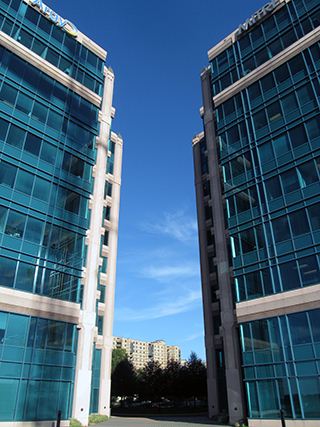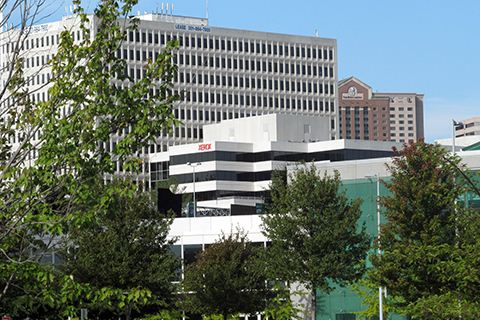 Driving, or crawling in some cases, along Route 123 and Route 7 through the heart of Tysons has often spurred the question, “Why would anyone want to build here?”. It’s an excellent question when viewed from the angle of the typical mall user or office park commuter. From that vantage it would appear that Tysons is no more than a decayed construction zone of parking lots and suburban sprawl. Many of the biggest cynics about the future of Tysons come from this population of visitors and workers whose daily exodus is the condition now being designed against by County planners and private developers.
Driving, or crawling in some cases, along Route 123 and Route 7 through the heart of Tysons has often spurred the question, “Why would anyone want to build here?”. It’s an excellent question when viewed from the angle of the typical mall user or office park commuter. From that vantage it would appear that Tysons is no more than a decayed construction zone of parking lots and suburban sprawl. Many of the biggest cynics about the future of Tysons come from this population of visitors and workers whose daily exodus is the condition now being designed against by County planners and private developers.
The misconception of Tysons future begins with the idea that the introduction of Metro’s silver line and the subsequent transportation improvements is the start of a new city. As important as transportation is, without the economics of why people congregate (jobs, commerce, trade) no city in the world would exist regardless of its ease of access. As it is, based on the economics, Tysons isn’t forming into a city, it is a city, which needs serious corrections in order to look the part. The Metro won’t be the beginning of its story, but rather a catalyst in the next step of transforming it.
So what are the economic fundamentals of Tysons and Fairfax County which prove this case?
 The most basic measure of an economy is gross domestic product (or in this case gross metropolitan product). It’s no surprise which cities lead this list (NYC-$1.3 trillion, LA-$736 billion, Chicago-$523 billion, Washington Metro-$425 billion, Houston-$385 billion). What may come as a surprise is Fairfax County’s standing on that list, #31 at $95 billion, which currently is not delineated separately from Washington Metro. Of course without the inclusion of Fairfax County (let alone Arlington, Montgomery, Howard, Loudoun, etc) Washington Metro would plummet to 10th on the list of the most economically powerful cities in America. Fairfax’s $95 billion annual GMP puts it above more famous cities such as Columbus-$93 billion, Sacramento-$93 billion, Las Vegas-$90 billion, and Austin-$86 billion. If Tysons is the commercial business district of Fairfax (and the rest of the county is also included in the Tysons Metropolitan region as was in the case of all the cities on this list) then by this measure it is already established as a city.
The most basic measure of an economy is gross domestic product (or in this case gross metropolitan product). It’s no surprise which cities lead this list (NYC-$1.3 trillion, LA-$736 billion, Chicago-$523 billion, Washington Metro-$425 billion, Houston-$385 billion). What may come as a surprise is Fairfax County’s standing on that list, #31 at $95 billion, which currently is not delineated separately from Washington Metro. Of course without the inclusion of Fairfax County (let alone Arlington, Montgomery, Howard, Loudoun, etc) Washington Metro would plummet to 10th on the list of the most economically powerful cities in America. Fairfax’s $95 billion annual GMP puts it above more famous cities such as Columbus-$93 billion, Sacramento-$93 billion, Las Vegas-$90 billion, and Austin-$86 billion. If Tysons is the commercial business district of Fairfax (and the rest of the county is also included in the Tysons Metropolitan region as was in the case of all the cities on this list) then by this measure it is already established as a city.
This again is in no way a measure of how nice of a city a place is, but instead a measure of the underlying growth capacity and sustainability of the region.
Another measure of a cities economic viability is its physical commercial size. To the average mall goer or Route 7 user it would appear that there is nothing in Tysons except for a few spots of office buildings and pavement as far as the eye can see. To really see Tysons you have to come off of the main roads which have been sacrificed to the gods of commute, and view regions along Jones Branch Drive, Greensboro Drive, Towers Crescent, Tysons Boulevard, and Boone Boulevard. These are the regions of Tysons which still maintain an urban fabric in the design of roads, walk paths (though improvements are badly needed), and the scale of development. In total Tysons has over 27 million square feet of commercial office space. This puts the growing city (only the commercial business district not including surrounding areas) as the 12th most developed commercial metropolitan in the Country. It is more developed than Dallas-26.9 million, Denver-26.5 million, Atlanta-17.3 million, and Indianapolis-14.7 million.

One might say this is an unfair measure, as much of the development in those cities listed occurs outside of the commercial business district in surrounding edge office parks and suburbs. Again, if this is the case, then Tysons metro would also include the remainder of Fairfax County, being the commercial business district, which would increase the metro development area to 105 million square feet of commercial office space. For comparison the entirety of DC within the districts boundaries has only 107 million square feet of office space.
One should question whether commercial office space is an accurate depiction of underlying economic fundamentals. It matters more how much of the space is occupied and how many people are employed.
We agree. While lease signs have become more prevalent in Tysons (as well as the rest of Fairfax) during the recession, this region has actually far outpaced occupancy of commercial space compared to other regions of the country. Fairfax County currently hovers between 12-15% vacancy rate. By comparison Atlanta’s vacancy rate is well above 20%, Dallas has a vacancy rate of 22.5%, and Denver (which has weathered the economy better than most) has a vacancy rate of 12.4%. In fact, by office vacancy Fairfax County would be in the upper quarter of US metropolitan regions. This has occurred during a relatively slow period of growth for the region as a whole, due to reduced growth in Federal consulting expenditures. Instead we are seeing the region as a whole decline in its dependence on Federal contracting counterbalanced with growth in the Telecommunication, Bio-medical, Health Care, Construction, Marketing, and Financial sectors.

By employment the numbers remain strong for Tysons at 115,000 employment positions. More importantly the entire Tysons metro region (Fairfax County) employs 581,500 within its boundaries, approximately the same as Dallas-585,000 and larger than downtown San Francisco-472,000, Indianapolis-423,000, and Denver-325,000. Now, it is unfair to imply that Fairfax County is a more powerful employment force than San Francisco (as this number does not include the surrounding regions of Palo Alto, San Jose, etc which make the Bay area one of the biggest employment hubs in America. What this does reflect however is the overall health of the workforce and is a secondary measure of the continued occupancy in office space of which Tysons is #12 in the country.
There are over 1,200 technology companies in Tysons Corner, many of which are small businesses which don’t solely operate as direct consultants to the Federal government. Booz Allen, Capital One, Freddie Mac, Gannett, Hilton, Microstrategy, SAIC, Space Adventures, Spacenet, Sunrise Senior Living, USA Today, Northrup Grumman, Lockheed, and Mitre all call Tysons home-base in the US. What has often been called a one horse town (defense contracting) has clearly branched out. At its core Tysons single largest horse remains federal consulting, but as horses go its a pretty good one to hitch to. Regardless of the current fiscal austerity necessary in federal spending, the future of America is bright and there is no reason to believe our standing as the worlds foremost economic power will be shook in this century.
 The point of all of these indicators and rankings is not to say that Tysons is a utopia to live in. It serves as foot posts to indicate that the core business and economics of this commercial business district are vibrant and still growing. What is missing from the city is proper planning/design and people, both of which are far easier to accommodate than the longer duration organic growth necessary to create a job hub.
The point of all of these indicators and rankings is not to say that Tysons is a utopia to live in. It serves as foot posts to indicate that the core business and economics of this commercial business district are vibrant and still growing. What is missing from the city is proper planning/design and people, both of which are far easier to accommodate than the longer duration organic growth necessary to create a job hub.
All of these indicators put Tysons at the same level as Charlotte and Denver in the mid-90s prior to their land use reforms. Since that period in both, after proper urban design was implemented, the transformation has been shocking and awakening to other mid-sized metropolitans in the country, underscoring a simple truth. When fundamentals are in place, physical urbanity is easy to come by.
Sources Metropolitan Employment – SOCDS Current Labor Force Data DC Employment – Bureau of Labor Statistics Fairfax Employment – Fairfax County Economic Development Authority Tysons Corner Corporate Information – Wikipedia Atlanta Office Space Vacancy – CarterBlog Dallas Office Space Vacancy – RealPoints Magazine Cushman & Wakefield Top 20 CBDs By Commercial Office Space – List